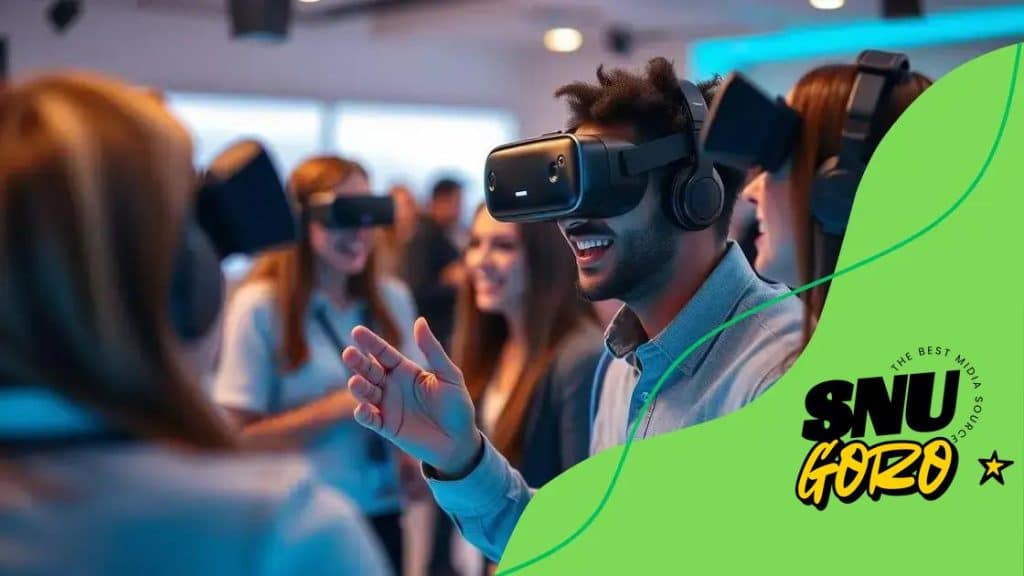Virtual reality’s impact on social interactions

Virtual reality’s impact on social interactions includes enhanced empathy, innovative communication methods, and challenges like privacy concerns and emotional effects, shaping how we connect in a digital age.
Virtual reality’s impact on social interactions is fascinating and evolving. Have you ever wondered how these immersive experiences might change the way we connect? Let’s dive in and explore.
Understanding virtual reality technology
Understanding virtual reality technology is essential for grasping its effects on our social lives. This technology transports users into a computer-generated environment, allowing them to interact with 3D worlds. But how does it really work, and what does it mean for our interactions with others?
Key Components of Virtual Reality
Virtual reality consists of several key components that work together to create immersive experiences. These include:
- Hardware: This category includes VR headsets, motion sensors, and controllers.
- Software: Programs that create the virtual environments we navigate.
- Interactivity: The degree to which users can influence and shape their experiences in real-time.
These elements come together to build a space where users can feel present, stimulating their senses and enhancing communication.
The Role of VR in Social Interactions
As people engage in virtual environments, their social interactions transform. Many users find it easier to communicate and form relationships in a virtual setting. This shift may stem from the anonymity and freedom that virtual reality offers.
In some situations, this technology helps break down barriers. It enables connections between individuals who might never meet in the real world. Whether through gaming, social platforms, or virtual events, the opportunities for interaction expand significantly.
The Benefits of Virtual Reality
Some notable benefits of virtual reality technology in enhancing social interaction include:
- Increased Engagement: Users are more likely to participate in discussions and activities.
- Enhanced Empathy: Experiencing different perspectives in VR can foster understanding.
- Dynamic Experiences: Immersive environments allow for richer communication.
With these advantages, it’s no wonder virtual reality is becoming more popular in daily life.
By understanding how virtual reality technology operates and impacts social connections, we can better appreciate its growing presence in our lives. As we continue to explore these digital spaces, we unlock new potentials for interaction and engagement that were once unimaginable.
Changing communication patterns through VR
Changing communication patterns through VR is reshaping the way we connect with others. As users dive into virtual environments, traditional methods of communication evolve. This transformation comes with exciting possibilities and challenges that are worth exploring.
How VR Changes Communication
In a virtual reality setting, communication becomes more immersive and multi-sensory. Users can see facial expressions, hear audio cues, and even use hand gestures. These elements create a sense of presence that enhances interaction. This leads not only to more engaging conversations but also to deeper emotional connections.
- Non-verbal cues: VR enables users to interpret body language and gestures.
- Spatial interactions: Being in the same virtual space promotes collaboration and teamwork.
- Personalization: Users can create avatars that reflect their personalities, enhancing identity expression.
These factors contribute to a richer communicative experience. Works of art that incorporate VR technology allow for unique and engaging storytelling methods, engaging people’s emotions in ways text or video cannot.
Enhancing Collaborative Efforts
Within virtual environments, collaboration among users becomes easier and more effective. Traditional online meetings can often feel flat, but when transformed into immersive VR experiences, participants can spatially interact. This new way of meeting allows individuals to brainstorm, strategize, and create in real-time, harnessing the power of being virtually “together.”
This transformation supports various sectors, from education to business. Students can collaborate with classmates from all over the world while working on projects, and teams can tackle assignments without geographical barriers. In essence, VR is dismantling communication obstacles and fostering creative problem-solving.
As these changing communication patterns evolve, embracing this technology opens the door to new connections that promote inclusivity and understanding. Whether it’s in gaming, training, or social interactions, the potential of VR continues to expand.
Building relationships in virtual environments

Building relationships in virtual environments is a fascinating and evolving aspect of social interaction today. As technology advances, virtual spaces provide unique opportunities for connecting with others. People are finding that friendships and partnerships can thrive in these digital realms.
The Role of Avatars
One significant aspect of virtual environments is the use of avatars. Avatars allow users to express themselves in ways that might not be possible in the real world. This personalization creates a sense of identity and community. When individuals interact through their avatars, they often feel more comfortable sharing thoughts and feelings.
- Enhanced expression: Avatars can reflect individual personalities, hobbies, or moods.
- Breaking barriers: Users may feel freer to connect without the constraints of their physical appearance.
- Facilitating interactions: Avatars enable users to find common ground with others based on shared interests.
The freedom to create a virtual persona fosters deeper conversations and connections between users.
Participating in Shared Experiences
In virtual environments, shared experiences play a crucial role in relationship building. Engaging in activities together, such as games or collaborative projects, strengthens bonds between individuals. These shared moments create memories that enhance emotional ties. As users navigate these experiences, they learn to trust and rely on each other more.
The ability to communicate and collaborate in real-time also contributes to deeper connections. As people interact in these environments, they develop teamwork skills, learning how to navigate challenges together.
With the growing popularity of online communities, building relationships is not limited by geography. Users can connect with others across the globe who share similar interests, hobbies, or experiences. This vast landscape offers countless opportunities to form friendships that may last a lifetime.
As more individuals embrace virtual environments, we may see a profound shift in how relationships develop, influenced by technology and the creativity of users navigating these spaces.
The influence of VR on empathy and understanding
The influence of VR on empathy and understanding is a remarkable aspect of this technology. Through immersive experiences, users can step into someone else’s shoes, gaining perspectives that may be difficult to access in real life. This ability to experience life from another viewpoint has powerful implications for building empathy.
Experiencing Different Perspectives
When users engage with virtual reality, they often find themselves in scenarios that challenge their perceptions. For instance, VR can simulate the experiences of people with different abilities, cultures, or backgrounds. By immersing themselves in these situations, individuals can develop a deeper understanding of others’ challenges and emotions.
- Real-life scenarios: Users can witness events from various angles, enhancing their comprehension of complex social issues.
- Emotional engagement: The immersive nature of VR helps evoke real feelings, promoting compassion.
- Educational opportunities: VR experiences can teach about empathy, tolerance, and understanding diverse perspectives.
This type of engagement encourages open-mindedness and reduces bias, contributing to healthier social interactions.
The Role of Storytelling in VR
The storytelling capabilities in virtual environments add another layer to understanding. Stories told through VR enables users to connect emotionally with characters and narratives. This connection encourages users to reflect on their values and beliefs.
As users navigate immersive stories, they often find themselves emotionally involved. This deep connection can lead to powerful discussions and a greater willingness to understand others. It’s not just about witnessing events; it’s about feeling them.
Virtual reality serves as a bridge, allowing individuals to explore complex subjects in an engaging manner. By fostering empathy and understanding, VR can motivate users to take meaningful actions in their communities and beyond.
Challenges and ethical considerations in VR interactions
Challenges and ethical considerations in VR interactions are crucial topics as virtual reality becomes more prevalent in our lives. While VR offers exciting opportunities, it also brings important issues that need careful attention.
Privacy and Data Security
One significant challenge in virtual reality is ensuring the privacy and security of user data. When people use VR, they often share personal information. This data can include preferences, locations, and even biometric details.
- Data collection: Companies may gather extensive data to enhance user experiences.
- Potential misuse: There is always a risk that this data could be mishandled or used for malicious purposes.
- User consent: It is vital for users to understand what data is collected and how it will be used.
Addressing these privacy concerns is essential to build trust in VR technologies.
Emotional and Psychological Impact
The emotional effects of VR interactions also warrant attention. Immersive experiences can lead to strong emotional responses. This power can be beneficial, but it can also have negative outcomes. For instance, users might experience:
- Over-immersion: Becoming too consumed by a VR environment can lead to real-life disconnection.
- Desensitization: Repeated exposure to intense experiences may lessen emotional reactions.
- Escapism: Some individuals may turn to VR to escape reality, potentially leading to issues in coping with real-world problems.
Understanding these potential impacts is important for creators and users alike.
Ethical guidelines must evolve as VR technology advances, ensuring that experiences are safe, respectful, and beneficial for all users. By navigating these challenges carefully, we can promote a thoughtful use of virtual reality and maximize its benefits while minimizing harm.
In conclusion, the impact of virtual reality on social interactions is profound and multifaceted. While VR enriches communication, empathy, and relationship-building, it also poses significant challenges and ethical dilemmas that we must address. Understanding these elements will help us navigate the virtual landscape responsibly. As we move forward, fostering a safe, inclusive, and respectful VR environment is crucial. By embracing these technologies wisely, we can unlock their full potential for positive social change.
FAQ – Frequently Asked Questions about Virtual Reality’s Impact on Social Interactions
How does VR enhance empathy?
VR allows users to experience life from different perspectives, which can lead to a greater understanding of others’ emotions and challenges.
What are the privacy concerns related to VR?
Users’ personal data, including preferences and locations, may be collected and used, raising issues of data security and user consent.
Can VR lead to emotional issues?
Yes, immersive experiences in VR can result in strong emotional responses, which may affect users’ interactions in the real world.
What ethical challenges does VR present?
Navigating the ethical implications of VR use is crucial to ensure safe, respectful, and beneficial experiences for all users.





